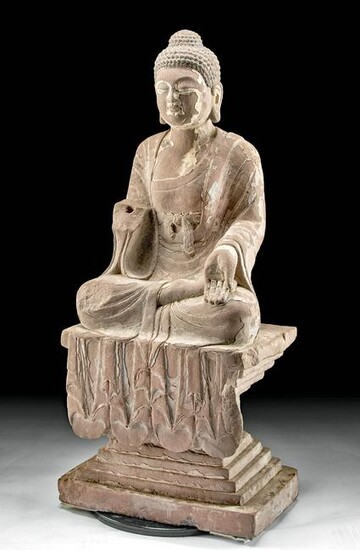Chinese Tang Dynasty Stone Seated Buddha / Shakyamuni
East Asia, China, Tang Dynasty, ca. 618 to 907 CE. A finely carved and stuccoed stone Buddha (Shakyamuni, the Enlightened form), dressed in traditional robes with an elegant knotted waist sash/belt and seated in full lotus position atop a throne with draped fabric, perhaps silk, cascading over the front, his outward facing left hand suggesting the abhaya mudra, the "gesture of fearlessness". Buddha's contemplative peaceful visage is comprised of downcast eyes, an elegant nose, pursed lips, and characteristically elongated ears - all topped by a curled ushnisha. Imbuing the piece with additional beauty and wonder are the liberal remains of polychrome stucco, suggesting that the statue was once quite colorful with hues of perhaps red, gold, and blue. Size: 8.75" L x 14.75" W x 32.25" H (22.2 cm x 37.5 cm x 81.9 cm)
Buddha's robes are skillfully rendered, draped in a naturalistic way, while his facial features are serene and lifelike. His hair is styled with the classic large ushnisha that indicates his enlightenment. The statue presents a peaceful countenance with the visage featuring a rounded ushnisha symbolizing the wisdom and knowledge acquired after attaining enlightenment, as well as elongated ears, a physical feature symbolic of the Buddha's time as a prince when he wore elaborate ear ornaments to demonstrate wealth and prosperity. Of course, the prince stopped wearing them when he left the palace to become an ascetic; however, his earlobes remained stretched signifying a conscious decision to reject the material world in exchange for spiritual enlightenment and simultaneously suggest that the Buddha can hear all that is asked for and needed in the earthly world. Those half-closed eyes indicate a meditative state - at once looking both outward and inward. Beyond the multi-layered meaning embodied in the iconography of this piece, the sculptor's artistry and technique are very impressive.
Provenance: private Hawaii, USA collection; Ex Micky Micklautz collection, Honolulu, Hawaii USA, 1945 to 1990
All items legal to buy/sell under U.S. Statute covering cultural patrimony Code 2600, CHAPTER 14, and are guaranteed to be as described or your money back.
A Certificate of Authenticity will accompany all winning bids.
We ship worldwide to most countries and handle all shipping in-house for your convenience.
#161288
Condition Report: Missing right hand. Chips to peripheries of base and high-pointed areas. Expected surface wear with loss to stucco, but ample traces of the polychrome stucco finish remain.
View it on
Estimate
Time, Location
Auction House
East Asia, China, Tang Dynasty, ca. 618 to 907 CE. A finely carved and stuccoed stone Buddha (Shakyamuni, the Enlightened form), dressed in traditional robes with an elegant knotted waist sash/belt and seated in full lotus position atop a throne with draped fabric, perhaps silk, cascading over the front, his outward facing left hand suggesting the abhaya mudra, the "gesture of fearlessness". Buddha's contemplative peaceful visage is comprised of downcast eyes, an elegant nose, pursed lips, and characteristically elongated ears - all topped by a curled ushnisha. Imbuing the piece with additional beauty and wonder are the liberal remains of polychrome stucco, suggesting that the statue was once quite colorful with hues of perhaps red, gold, and blue. Size: 8.75" L x 14.75" W x 32.25" H (22.2 cm x 37.5 cm x 81.9 cm)
Buddha's robes are skillfully rendered, draped in a naturalistic way, while his facial features are serene and lifelike. His hair is styled with the classic large ushnisha that indicates his enlightenment. The statue presents a peaceful countenance with the visage featuring a rounded ushnisha symbolizing the wisdom and knowledge acquired after attaining enlightenment, as well as elongated ears, a physical feature symbolic of the Buddha's time as a prince when he wore elaborate ear ornaments to demonstrate wealth and prosperity. Of course, the prince stopped wearing them when he left the palace to become an ascetic; however, his earlobes remained stretched signifying a conscious decision to reject the material world in exchange for spiritual enlightenment and simultaneously suggest that the Buddha can hear all that is asked for and needed in the earthly world. Those half-closed eyes indicate a meditative state - at once looking both outward and inward. Beyond the multi-layered meaning embodied in the iconography of this piece, the sculptor's artistry and technique are very impressive.
Provenance: private Hawaii, USA collection; Ex Micky Micklautz collection, Honolulu, Hawaii USA, 1945 to 1990
All items legal to buy/sell under U.S. Statute covering cultural patrimony Code 2600, CHAPTER 14, and are guaranteed to be as described or your money back.
A Certificate of Authenticity will accompany all winning bids.
We ship worldwide to most countries and handle all shipping in-house for your convenience.
#161288
Condition Report: Missing right hand. Chips to peripheries of base and high-pointed areas. Expected surface wear with loss to stucco, but ample traces of the polychrome stucco finish remain.



